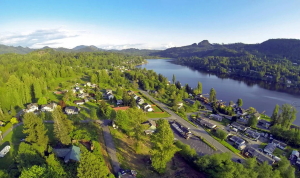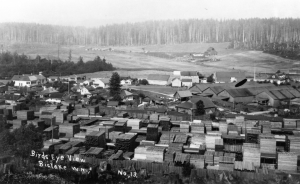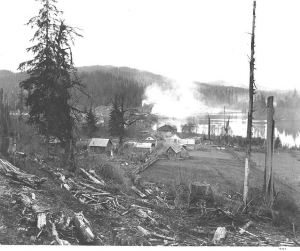Settlement of Nearby Areas
Montborne

The old town of Montborne is located on the east side of Big Lake within the triangle created by the Walker Valley Road and Montborne Road (next to the Big Lake Bar and Grill). Montborne was the closest established settlement to the Walker Valley. Montborne was originally settled in 1884 by Dr. H.P. Montborne, a pioneering physician in Mount Vernon. Dr. Montborne sold his land claim to the Virginia Land & Trust Company in 1890, which was soon acquired by the Seattle, Lakeshore, and Eastern Railroad Company then in the process of constructing a railroad from Seattle to Sedro (now Sedro-Wooley). In the 1890’s Montborne owed its existence exclusively to the railroad and local timbering opportunities. It had a railroad station on the Northern Pacific Line, the Montborne Hotel (actually a boarding house), a general store, and small sawmills. At its height, Montborne had a population of about 200.

In 1901 Montborne was selected by the Nelson-Neal Lumber Company as the site of its new shingle mill. The mill was completed and went into operation in July 1903. The mill was used for the manufacture of both shingles and lumber. John Nelson, president and a namesake of the company, was based at Montborne at this time. Lumber from all around the Big Lake area, though primarily the southern part, was brought here for processing. In 1918 Nelson-Neal consolidated its activities at Montborne and began constructing a railroad east towards Walker Valley. One part of a switchback in the railway went up the hill from Big Lake at approximately the point where Walker Valley Road branches off Highway 9. Indeed, the Walker Valley Road approximately follows this railroad grade all the way to its end. By 1927 the Montborne Logging Company, successor to Nelson-Neal, was building a railroad grade up Cultus Mountain. In 1935 Reid Nelson, son of Nelson-Neal co-founder John Nelson, built the current truck road from Montborne to Cultus Mountain. The decline of Montborne was hastened when the mill burned down in the 1930’s. From about this time Montborne evolved from a lumber town to its current status as a residential community. The small cluster of old houses between Hwy. 9 and Walker Valley Road are all that remain of old Montborne. The mill was located below and on the lakeshore side of Westview Street, which connects with Highway 9.
Ehrlich
Ehrlich was a small settlement located in the valley starting at the south end of Big Lake and extending in the direction of Lake McMurray. It was first homesteaded by Joseph and Anna Theiler of Switzerland and initially known as Theiler’s Spur when the railroad was built through the area in the 1890’s. The area was renamed Ehrlich after Frank Ehrlich of Seattle built a shingle mill there in 1900. The town at one time had a post office, general store, and a railroad station. Several mills existed in the Ehrlich vicinity in the early 1900s, including the Pingry-Day Mill. In 1910 the Nelson-Neal Lumber Company acquired holdings in and around Ehrlich and used a railroad grade formerly held by the Northern Pacific line to transport lumber to Big Lake. Nelson-Neal closed its operations there in 1918, after which Ehrlich faded into oblivion. Highway 9 follows part of the old railway grade through this area, which is now covered by farms and forest. The fire station located here uses the name “Ehrlich Station.”
Big Lake

The modern settlement of Big Lake is located at the north end of the lake. It was spurred on by the building of the Seattle Lakeshore, and Eastern Railway, which opened up the area for large-scale logging operations. Big Lake served as the company town for the Day Lumber Company, which did most of the initial logging of the Walker Valley and Cultus foothills. Day built a mill at Big Lake, and by 1909 the town was thriving. The Day Lumber Co. owned the store, community hall, worker residences, hospital, and a farm where horses used in logging operations and dairy cows were kept. Big Lake also had its own post office (adjacent to the company store). At its height it was home to around 800 people. The mill, at its peak, produced as much as 21,452,600 feet of lumber and 60,000,000 shingles a year. Big Lake’s fortunes declined with those of the Day Lumber Company.
Lake McMurray

Lake McMurray, like Big Lake, was a town spurred by the construction of a railroad through the area. McMurray’s townsite was plotted in 1890 by Dr. Marcus Kenyon on the west side of the lake while a railroad route was being surveyed out from Conway to the west. The current highway approximates the former railway route. By the time the railway reached the lake, McMurray already had a hotel, store, and post office. Soon after the railroad was completed a shingle mill was already in operation. From 1896 to 1920 the Atlas Shingle and Lumber Company logged the steep surrounding hills for shingles and lumber. McMurray formally incorporated in 1910, by which time it already had several churches, fraternal organization lodges, and a school. At its height, McMurray was home to 500 people. Atlas closed the mill in 1923. Like Montborne and Big Lake, McMurray became a small, rural community once the local timber supply was exhausted.
Traces of logging days still exist in McMurray. From the McMurray gas station on Hwy. 9, follow a road leading down the tracks and back up from the lakeshore to the old mill site, now a small boat landing with some mobile homes. A little south of the gas station on Hwy. 9 is the former town center, with some old houses remaining. A private road leading to the lakeshore leads to the former site of the McMurray train depot.